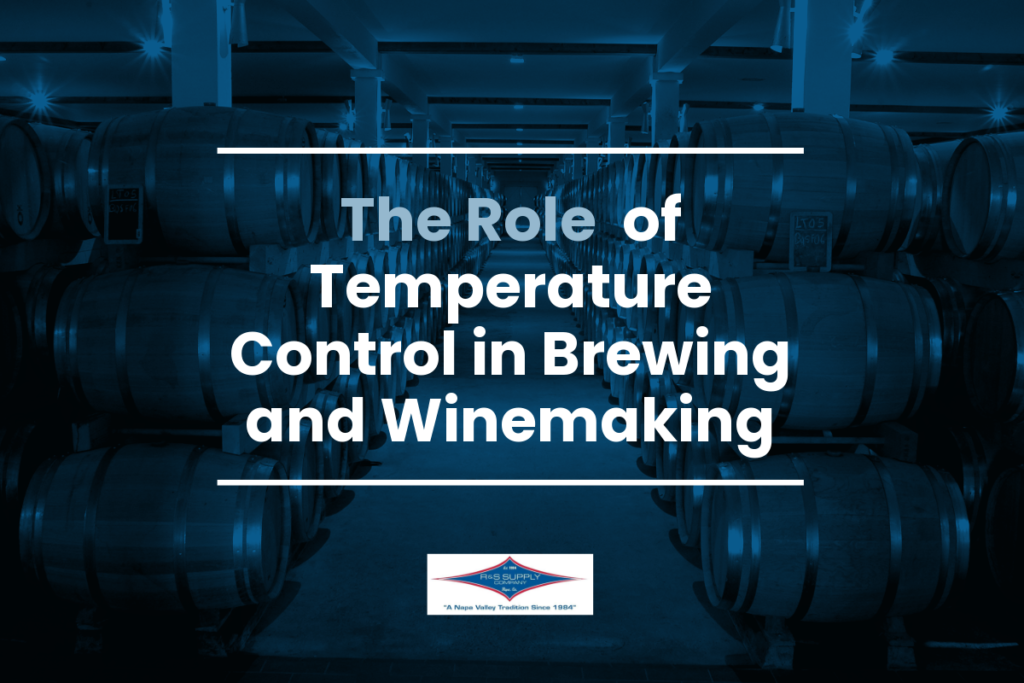Temperature control is a critical factor in both brewing and winemaking. It affects everything from fermentation efficiency to flavor development. At R&S Supply, we understand the importance of maintaining precise temperature conditions to achieve the best results in your beer and wine production. In this article, we’ll explore the crucial role temperature control plays and offer tips on managing it effectively.
Why Temperature Control Matters
Yeast Activity and Fermentation
The yeast responsible for fermentation is highly sensitive to temperature. Its activity determines the speed of fermentation and the profile of the final product.
Brewing:
Ale Yeast:
Typically ferments best between 60-72°F (15-22°C). This range produces ales with fruity esters and phenolic compounds.
Lager Yeast:
Prefers cooler temperatures, usually between 45-55°F (7-13°C), resulting in a cleaner, crisper taste.
Winemaking:
White Wines:
Ferment at cooler temperatures (50-60°F or 10-15°C) to preserve delicate aromas and flavors, ensuring freshness and subtlety.
Red Wines:
- Fermented at warmer temperatures (68-86°F or 20-30°C) to enhance the extraction of tannins and color, which contribute to the wine’s body and structure.
Different yeast strains are selected based on their optimal fermentation temperatures and the desired flavor profiles. For instance, some Belgian-style beers intentionally push yeast to its higher temperature range to create complex fruity or spicy esters. In winemaking, extended fermentation at controlled temperatures can allow for nuanced extraction of compounds from grape skins.
Flavor Development
Temperature is one of the primary drivers of flavor and aroma creation during fermentation.
Brewing:
Higher Temperatures:
Tend to produce more esters and phenols, leading to fruity and spicy notes in the beer.
Lower Temperatures:
- Lead to a cleaner, more subtle flavor, ideal for certain beer styles such as lagers.
Winemaking:
Cooler Fermentations (White Wines):
Help preserve floral, citrus, and fruit notes. This temperature control is crucial for developing a fresh and lively wine.
Warmer Fermentations (Red Wines):
Enhance the extraction of deeper, richer flavors, such as tannins and berry notes, creating wines with greater complexity and aging potential
Fine-tuning temperature during fermentation allows brewers and winemakers to craft specific profiles. For example, adjusting just a few degrees can dramatically change the intensity of fruity esters in a beer or soften the tannic edge of a young red wine.
Preventing Off-Flavors
Uncontrolled temperature fluctuations during fermentation can lead to undesirable flavors and spoilage.
Brewing:
Diacetyl:
- A common off-flavor caused by fluctuating temperatures, resulting in an unpleasant buttery taste.
Fusel Alcohols:
- Produced at higher-than-recommended temperatures, they give beer harsh, solvent-like notes.
Winemaking:
Volatile Compounds:
- High temperatures can cause the loss of delicate aromas and encourage the development of undesirable flavors.
Warmer Fermentations (Red Wines):
Enhance the extraction of deeper, richer flavors, such as tannins and berry notes, creating wines with greater complexity and aging potential
Regular monitoring helps avoid these risks. For example, implementing a “diacetyl rest” at the end of fermentation can help brewers reduce the buttery flavor. Winemakers use precise temperature control to prevent the loss of volatile compounds crucial for the aroma profile of fine wines.
An essential guidance on how to effectively manage fermentation temperatures for optimal beer quality.
Tools and Techniques for Temperature Control

Fermentation Vessels with Temperature Control
Brewing:
Modern fermentation vessels, especially in commercial brewing, often have glycol jackets or heating/cooling elements. These systems allow brewers to maintain precise temperatures throughout the fermentation process.
Winemaking:
Stainless steel fermenters with temperature regulation capabilities, such as cooling jackets or coils, are standard. These allow winemakers to adjust the fermentation temperature to suit the desired wine profile.
Many large-scale brewing and winemaking operations utilize integrated digital control systems to maintain exact temperatures. These systems can be programmed to follow a temperature curve over time, allowing gradual adjustments to support different stages of fermentation.
Temperature Monitoring Devices
Brewing:
- Thermometers: Essential for tracking the fermentation temperature in real-time.
- Digital Controllers: Automate the temperature control process by adjusting cooling or heating elements based on real-time temperature readings.
Winemaking:
- Thermocouples: Widely used by winemakers to monitor temperature during fermentation.
- Digital Sensors: Provide precise, real-time data, allowing winemakers to make informed adjustments.
Automated temperature monitoring is becoming increasingly popular in homebrewing and small-scale winemaking. These devices enable remote temperature monitoring via apps, allowing producers to maintain optimal conditions without constant supervision.
Cooling and Heating Systems
Brewing:
- Homebrewers: Often use immersion chillers or fermentation chambers (refrigerators) to regulate temperature.
- Commercial Brewers: Typically utilize glycol cooling systems that control the temperature of multiple fermentation tanks simultaneously.
Winemaking:
- Cold Rooms: Ideal for fermenting at lower temperatures or storing finished wine.
- Portable Chillers: Useful in controlling fermentation temperature in smaller-scale or off-site production.
Larger brewing and winemaking operations often use zoned cooling systems, where different sections of a fermentation room are kept at different temperatures, allowing producers to ferment multiple styles at the same time.
Best Practices for Temperature Control

In regions with dramatic seasonal temperature shifts, utilizing programmable temperature controllers with heating and cooling capabilities helps prevent undesirable fermentation issues, such as stuck fermentation in winter or excessive ester production in summer.
Consistent Monitoring
Always keep a close eye on fermentation temperatures using reliable thermometers or digital sensors. Ensure prompt adjustments to maintain the desired temperature range.
Insulation
Utilize insulated fermentation vessels or keep the fermentation environment temperature-controlled to minimize fluctuations. This helps maintain a stable fermentation process.
Gradual Changes
Avoid sudden temperature shifts, which can stress the yeast and result in incomplete fermentation or undesirable flavors. Make slow, controlled adjustments for the best results.
Seasonal Considerations
Adjust your temperature control strategy based on seasonal variations. Warmer weather may require more cooling efforts, while cooler months might necessitate heating.
Temperature control is a vital aspect of both brewing and winemaking, influencing yeast activity, flavor development, and overall product quality. By understanding the science of temperature management and using the right tools and techniques, brewers and winemakers can consistently produce high-quality results. Whether brewing a crisp lager or fermenting a complex red wine, mastering temperature control is key to success.

